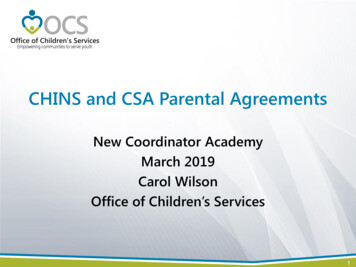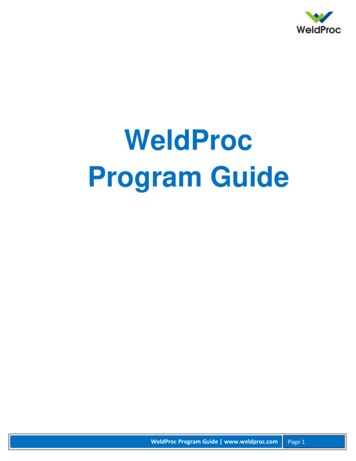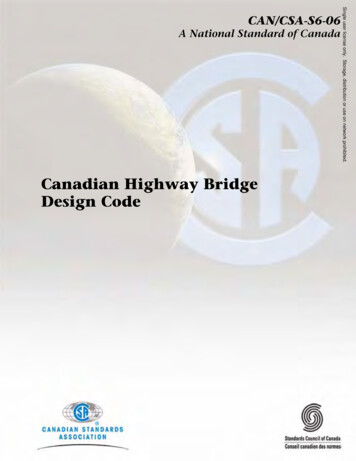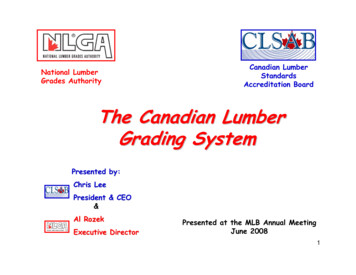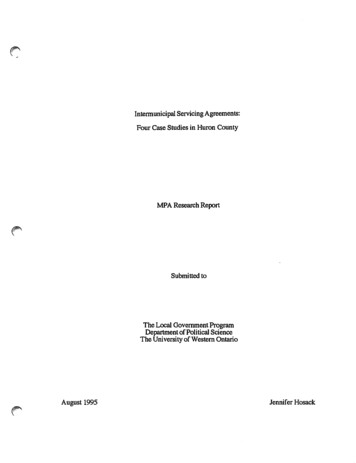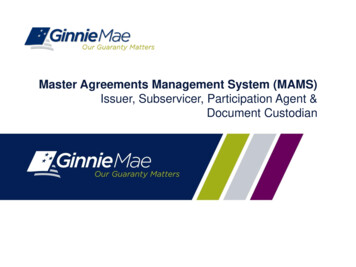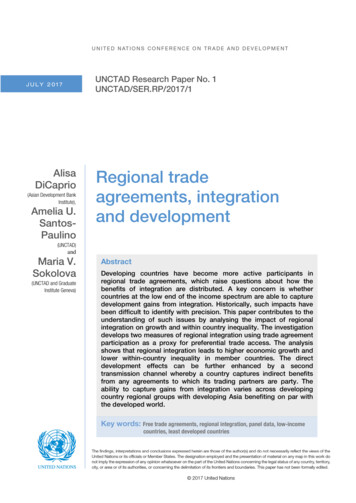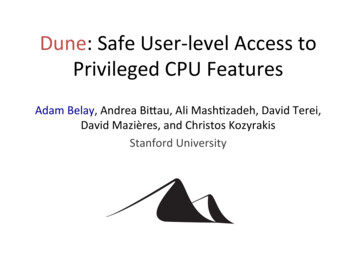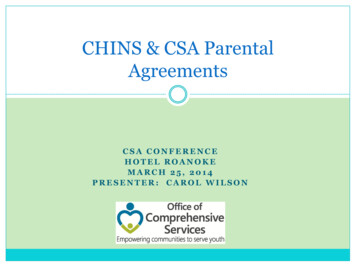
Transcription
CHINS & CSA ParentalAgreementsCSA CONFERENCEHOTEL ROANOKEMARCH 25, 2014PRESENTER: CAROL WILSON
Workshop Outline Origin of the CHINS Checklist and CSA Parental Agreements (Why do we have them? What is theirpurpose?)Target PopulationHow does CHINS Foster Care Services CSA?Eligibility ChecklistCSA Parental Agreements Role of Parent/GuardianPractice Issues
Why the Guidelines? Interagency Guidelines for the Provision of Foster CareServices to Specific Children in Need of Services, CHINS Eligibility Checklist; and the CSA Parental Agreementresulted from a 2006 Attorney General’s opinion regardingcustody relinquishment.
Custody Relinquishment What is custody relinquishment? Some parents objected as they should be able to obtainmental health treatment for their children just as they wereable to obtain physical health treatment for them.
Earlier Effort to Resolve Earlier attempt to resolve the problem was 1997 Code ofVirginia revision to allow for “non-custodial” agreementswhere: Parent retained legal custody; and child was Child placed out-of-home for mental health treatment.
Earlier Effort to Resolve Problems Remained as “Non-Custodials” Required localinvolvement of :Department of Social Services (LDSS); and Court
Earlier Effort to Resolve And . At that time, some localities did not enter into noncustodials and still required parents to relinquish custodyfor children to receive mental health services.
Attorney General’s Opinion Opinion rendered in December 2006 whichstrongly stated that no parent in theCommonwealth of Virginia should ever have torelinquish custody to obtain mental healthtreatment for a df
Operationalizing the Opinion How could the requirements of the AG’s opinion beput into practice? Interagency Guidelines were developed based on theAG’s opinion under the direction of the StateExecutive Council, the policy and oversight body forCSA.
Interagency Guidelines The Interagency Guidelines created a mechanism toenable a child to be determined “in need of services”(CHINS) by the Family Assessment and PlanningTeam (FAPT) without Court or LDSS casemanagement. Prior to the AG’s Opinion, the interpretation of theCOV (§16.1-228) was that only the Court could makea determination that a child was a “CHINS”.
Why? Why was it important to have a child determined tobe “in need of services”? If a child is determined to be “in need of services”, heor she may be eligible for CSA-funded “mandated”foster care services. Now either the Court or the Family Assessment andPlanning Team (FAPT) could determine a child to beCHINS.
“Foster Care”-what does it mean? Federal definition of “foster care” 24 hour substitute care for children placed away from parentor guardian for whom the State agency (meaning the StateChild Welfare Agency) has placement and care responsibility(45 C.F.R. §1355.20)Does not require that the child be in the legal custody of theState agency
Statutory Definition of “Foster Care Services” in VirginiaCode of Virginia“63.2-905. Foster care services.Foster care services are the provision of a full range of casework, treatment andcommunity services, including but not limited to independent living services,for a planned period of time to a child who is abused or neglected as defined in§ 63.2-100 or in need of services as defined in § 16.1-228 and his family whenthe child (i) has been identified as needing services to prevent or eliminate theneed for foster care placement, (ii) has been placed through an agreementbetween the local board or the public agency designated by the communitypolicy and management team and the parents or guardians where legal custodyremains with the parents or guardians, or (iii) has been committed or entrustedto a local board or licensed child placing agency. Foster care services alsoinclude the provision and restoration of independent living services to a personwho is over the age of 18 years but who has not yet reached the age of 21 years,in accordance with § 63.2-905.1.”
Foster Care Services in Virginia The Code of Virginia does not have a definition of “foster care”,rather defines “foster care services.” Code defines “foster care services” as “the provision of a fullrange of casework, treatment and community services ” (COV§63.2-905). Foster care services are “sum-sufficient” or mandated (COV§2.2-5211).
Foster Care Services The Code (§63.2-905) provides for three types of“foster care services” Foster care prevention (to prevent or eliminate the need forfoster care placement)Agreement between parent/guardian and the local board oragency designated by the Community Policy and ManagementTeam (CPMT) and the parent/guardian retains legal custodyCommitment or entrustment to LDSS or a licensed childplacing agency (includes custody)
Foster Care Services These three types of services: are separate and distinct categories; anddo not overlap; an agreement between a parent and agencywhere parent retains custody is not foster care prevention.
Foster Care Services Eligibility for CSA Code of Virginia (§63.2-905) states there are two populationsof children that are eligible for CSA foster care services: Children who meet the statutory definitions of: Abuse/neglect in COV §63.2-100 or Child in need of services (CHINS) as defined in COV §16.2-228
Two Eligible PopulationsAbuse/Neglect Eligible for “foster careservices” including preventionof foster care placement No need to use CHINS checklistto determine eligibility No standard checklist todetermine eligibility for thispopulationCHINS Eligible for “foster careservices”, including preventionof foster care placement Court determines or FAPT usesCHINS Checklist to determineeligibility as CHINS
Once in theEligibilityDoor Child is eligible for all three typesof “foster care services” Foster care preventionAgreement between parent/guardianand the local board or an agencydesignated by the CPMT where theparent retains custodyCustody or entrustment to LDSS or anLCPA
To repeat: Eligibility for CSA The “Interagency Guidelines” do NOT affect the provision ofservices to children who are receiving foster care servicesbecause of abuse or neglect. The Interagency Guidelines, CHINS Eligibility Checklist andCSA Parental Agreement documents refer ONLY to the secondpopulation of children (CHINS).
Not a “Foster Care Prevention” Checklist Consequently, the CHINS Eligibility Checklist is NOT a “fostercare prevention” checklist.
Foster Care Services Guidelines Documents Interagency Guidelines for the Provision of Foster CareServices to Specific Children in Need of ServicesAttachment A-CHINS Eligibility Checklist Attachment B-CSA Parental Agreement template VDSS Non-Custodial Foster Care Agreement
Interagency Guidelines Comprehensive document which outlines policyregarding the use of the CHINS eligibility checklistand the CSA parental agreement: Who is not eligibleWho may be eligibleCriteria for FAPT decisionType of servicesRole of parent/guardianCase managementService planning and review
Who is not eligible? Children who are in “foster care” through custody, commitment or entrustment to a LDSS or licensedchild placing agency by the court.Children who are abused or neglected, as defined in §63.2-100, and receive foster careservices, including: foster care prevention servicesservices to children who have been committed or entrusted to the LDSS or licensed child placing agency by the court(including children placed in the care and custody of LDSS through a “relief of care and custody” petition granted by thecourt);Placement through a noncustodial agreement between the LDSS and the parent or legal guardian who retains legal custodyChildren in need of supervision, delinquents, or truants referred by the court.Children who are eligible for special education services though CSA (§2.2-5211Csubdivisions B1 and B2.)Children who are eligible for non-mandated services through CSA, as identified in the CSAtarget populations (§2.2-5211C subdivisions B4 and B5). These children are: “Placed by a juvenile and domestic relations district court, in accordance with the provisions of §16.1-286, in a private orlocally operated public facility or nonresidential program, or in a community or facility-based treatment program inaccordance with the provisions of subsections B or C of §16.1-284.1; and“Committed to the Department of Juvenile Justice and placed by it in a private home or in a public or private facility inaccordance with §66-14.”“Childrenin need of services,” children with mental health needs, or children who needresidential care who do not otherwise meet the eligibility guidelines in this document.
Who may be eligible? Children who meet the statutory requirements forCSA found in COV §2.2-5212 regardingemotional/behavioral disorders; and Who meet the statutory definition of CHINS; and Level of need is severe enough that intervention isneeded to either prevent out of home placement ormaintain home placement Remember target population
CHINS Eligibility Checklist Provides an alternative to Court determination of CHINS If court determines child to be CHINS, criterion #1 ismet. FAPT may determine that a child is “in need of services”using the Eligibility Checklist for documentation. All four criteria must be met (“does”- “is”).
Checklist Checklist is completed by FAPT; child meets all fourcriteria. Child is eligible for either: Services in the community (prevention of foster care)CSA Parental Agreement is NOT needed.OR Services outside of the home in a treatment setting such asresidential, group home, or treatment foster care CSA Parental Agreement is needed.
Case Management Who will case-manage a child in need of services? Agencies at FAPT/CPMT are: Department of Social Services Local school division Court Services Unit Community Services Board Local CSA officeCase management decision is based on child’s bestinterests
Two Options The Code of Virginia defines foster care services toinclude two options for placement when a parentretains legal custody:COV §63.2-905 (ii) has been placed through an agreement between the local board or the publicagency designated by the community policy and management team and the parents orguardians where legal custody remains with the parents or guardians DSS Non-Custodial Foster Care AgreementCSA Parental Agreement
DSS and Non-Custodial Foster Care LDSS may not case manage CSA ParentalAgreements. Comparable agreement is the non-custodial. LDSS case manages, child placed outside of home isconsidered in foster care. Federal laws and benefitsapply. Child does not have to be in legal custody of LDSS tobe “in” foster care.
Similarities (VDSS Non-Custodial and CSA ParentalAgreement) Parents retain legal custody. Child is placed outside of the home for the purposeof treatment of emotional/behavioral issues. Placement is in a treatment setting.
Some DifferencesDSS Non-CustodialCSA Parental Agreement DSS is case manager Child is in foster care Agency other than LDSS isplacement-all federal andstate foster carerequirements must bemet Court involvementrequired Eligibility for federalbenefits (Medicaid, IV-E,etc.) must be determinedcase manager Child is receiving a “fostercare service” and is not infoster care placement Court involvement is notrequired Child is not eligible for IVE. May be eligible forMedicaid based on parents’income.
CSA Parental Agreement CSA Parental Agreement is a contract between theparents/guardians and the agency designated by theCPMT. The CPMT has fiscal responsibility. Terms include the rights and responsibilities of theparent/guardian, what is expected of the agency,financial terms and length of agreement.
CSA Parental Agreement Parties must agree that out of home placement is: In the child’s best interests,Most appropriate and least restrictive setting to meet child’sneeds; andMutually agreed upon by the FAPT and the parents/legalguardians.CSA Parental Agreements are voluntary agreements.
Role of Parent/Guardian CSA Parental Agreement Parent retains legal custody. Voluntary agreement! Focus is on treatment of child, notparent’s ability to care for or provide a safe home for child. Parent/guardian is actively involved in all phases ofassessment, decision-making, service delivery and review. Goal is always to return home. Parent places child, not agency. Parent may remove at anytime, per the terms of the individual agreement. Residence of parent/guardian matters. Determine fiscal responsibility of all parties.
CSA Parental Agreement Parent changes residence to another locality-whathappens? Parent moves out of state-what happens?
Potential Problems CSA Parental Agreements are not appropriate if childand family are receiving services because of abuse and/orneglect. VoluntaryParent retains legal custodyNo court involvementMay not be used as an alternative to foster care placement whenabuse/neglect is present CSA Parental Agreements are not a substitute for fostercare placement. Focus is treatment, not protection or permanencyChild does not have same federal and state protections as a child infoster care
Potential Problems CSA Parental Agreements are not appropriate if“permanency” is an issue for the child and family. Child placed in foster care has the protection offederal and state law which require movementtowards permanent placement, e.g., return home,adoption, relative placement. Child does not havethis protection with CSA parental agreements andmay “languish” in placement.
Potential Problems Length of stay Short term! Set target date. If child still in need of treatmenton that date, review plan. Placement may not last indefinitely. CSA requires utilization review.
Age of Youth Child in need of services means “(i) a child whose behavior, conduct or condition presents or resultsin a serious threat to the well-being and physical safety of the child or(ii) a child under the age of 14 whose behavior, conduct orcondition presents or results in a serious threat to the well-being andphysical safety of another person; ” COV §16.1-228 (emphasis added)Why is there a stipulation about the age of the youth if the threat is toanother person?
Age of Youth Children who are placed through CSA ParentalAgreements may continue to receive services pasttheir 18th birthday to complete treatment. If youth attains age 18 while placed, consent of youthto placement must be obtained. CSA Parental Agreements may not be entered intowith youth age 18 or older.
Court Involvement CSA Parental Agreements were created to provide analternative to court involvement for parents whosought a placement for mental health treatment for achild. There is no statutory requirement for a “child inneed of services” as determined by the FAPT to beinvolved with the court. CSA Parental Agreements do not include or addressthe role of the court.
Court Involvement Court may determine a child to be a “child in need ofservices.” Court has the dispositional alternative of ordering aplacement through an agreement between LDSS oragency designated by the CPMT where parent retainslegal custody (COV §16.1-278.4).Court must be involved with non-custodial foster careagreements.
Court Involvement Use of voluntary CSA Parental Agreement is notconsistent with court order of treatment.
Court Involvement Because it was not developed for this purpose, theCSA Parental Agreement template may not be a goodfit for situations where the court orders a placementthrough an agreement between an agency designatedby the CPMT and the parent, where the parentretains legal custody.
Practice Issues Problems with CSA parental agreements usuallyarise when agreement has been used inappropriately,such as: Court is involvedChild is in need of permanencyNo target date set for termination of agreementNo agreement on what constitutes successful completion oftreatmentParent moves to another locality or state
For more information: CSA Parental Agreements, contact the Office ofComprehensive Services or go to the Resource Librarypage at www.csa.virginia.gov Attorney General Opinion on Custody Relinquishment05-095-Fralin.pdf VDSS Non-Custodial Foster Care Agreements, contactyour Regional VDSS Permanency Consultant.
Who is not eligible? Children who are in "foster care" through custody, commitment or entrustment to a LDSS or licensed child placing agency by the court. Children who are abused or neglected, as defined in §63.2-100, and receive foster care services, including: foster care prevention services services to children who have been committed or entrusted to the LDSS or licensed child placing .
